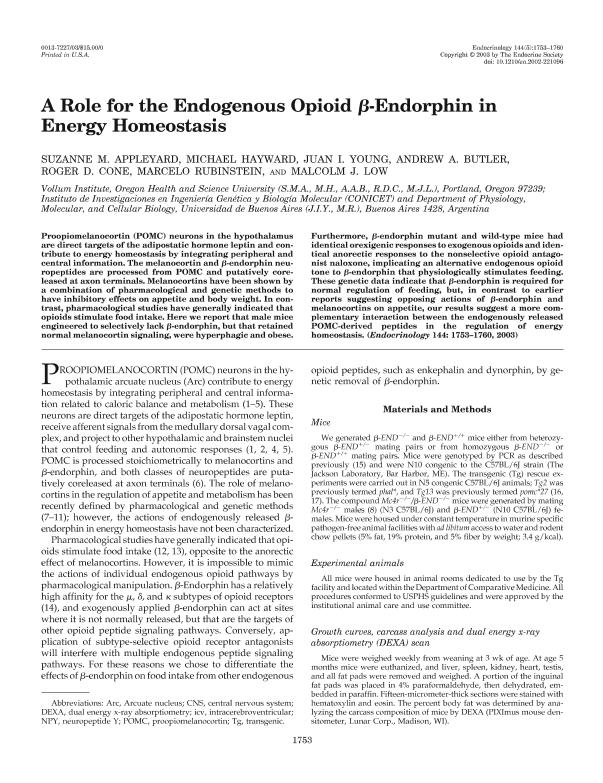Mostrar el registro sencillo del ítem
dc.contributor.author
Appleyard, Suzanne M.
dc.contributor.author
Hayward, Michael
dc.contributor.author
Young, Juan I.
dc.contributor.author
Butler, Andrew A.
dc.contributor.author
Cone, Roger D.
dc.contributor.author
Rubinstein, Marcelo

dc.contributor.author
Low, Malcolm J.

dc.date.available
2019-07-18T20:15:06Z
dc.date.issued
2003-05
dc.identifier.citation
Appleyard, Suzanne M.; Hayward, Michael; Young, Juan I.; Butler, Andrew A.; Cone, Roger D.; et al.; A role for the endogenous opioid β-endorphin in energy homeostasis; Endocrine Society; Endocrinology; 144; 5; 5-2003; 1753-1760
dc.identifier.issn
0013-7227
dc.identifier.uri
http://hdl.handle.net/11336/79846
dc.description.abstract
Proopiomelanocortin (POMC) neurons in the hypothalamus are direct targets of the adipostatic hormone leptin and contribute to energy homeostasis by integrating peripheral and central information. The melanocortin and β-endorphin neuropeptides are processed from POMC and putatively coreleased at axon terminals. Melanocortins have been shown by a combination of pharmacological and genetic methods to have inhibitory effects on appetite and body weight. In contrast, pharmacological studies have generally indicated that opioids stimulate food intake. Here we report that male mice engineered to selectively lack β-endorphin, but that retained normal melanocortin signaling, were hyperphagic and obese. Furthermore, β-endorphin mutant and wild-type mice had identical orexigenic responses to exogenous opioids and identical anorectic responses to the nonselective opioid antagonist naloxone, implicating an alternative endogenous opioid tone to β-endorphin that physiologically stimulates feeding. These genetic data indicate that β-endorphin is required for normal regulation of feeding, but, in contrast to earlier reports suggesting opposing actions of β-endorphin and melanocortins on appetite, our results suggest a more complementary interaction between the endogenously released POMC-derived peptides in the regulation of energy homeostasis.
dc.format
application/pdf
dc.language.iso
eng
dc.publisher
Endocrine Society

dc.rights
info:eu-repo/semantics/openAccess
dc.rights.uri
https://creativecommons.org/licenses/by-nc-sa/2.5/ar/
dc.subject
Endorfinas
dc.subject
Obesidad
dc.subject.classification
Neurociencias

dc.subject.classification
Medicina Básica

dc.subject.classification
CIENCIAS MÉDICAS Y DE LA SALUD

dc.title
A role for the endogenous opioid β-endorphin in energy homeostasis
dc.type
info:eu-repo/semantics/article
dc.type
info:ar-repo/semantics/artículo
dc.type
info:eu-repo/semantics/publishedVersion
dc.date.updated
2019-07-16T14:12:55Z
dc.journal.volume
144
dc.journal.number
5
dc.journal.pagination
1753-1760
dc.journal.pais
Estados Unidos

dc.journal.ciudad
Los Angeles
dc.description.fil
Fil: Appleyard, Suzanne M.. Oregon Health and Science University; Estados Unidos
dc.description.fil
Fil: Hayward, Michael. Oregon Health and Science University; Estados Unidos
dc.description.fil
Fil: Young, Juan I.. Consejo Nacional de Investigaciones Científicas y Técnicas. Instituto de Investigaciones en Ingeniería Genética y Biología Molecular "Dr. Héctor N. Torres"; Argentina. Universidad de Buenos Aires. Facultad de Ciencias Exactas y Naturales. Departamento de Fisiología, Biología Molecular y Celular; Argentina
dc.description.fil
Fil: Butler, Andrew A.. Oregon Health and Science University; Estados Unidos
dc.description.fil
Fil: Cone, Roger D.. Oregon Health and Science University; Estados Unidos
dc.description.fil
Fil: Rubinstein, Marcelo. Consejo Nacional de Investigaciones Científicas y Técnicas. Instituto de Investigaciones en Ingeniería Genética y Biología Molecular "Dr. Héctor N. Torres"; Argentina. Universidad de Buenos Aires. Facultad de Ciencias Exactas y Naturales. Departamento de Fisiología, Biología Molecular y Celular; Argentina
dc.description.fil
Fil: Low, Malcolm J.. Oregon Health and Science University; Estados Unidos
dc.journal.title
Endocrinology

dc.relation.alternativeid
info:eu-repo/semantics/altIdentifier/doi/http://dx.doi.org/10.1210/en.2002-221096
dc.relation.alternativeid
info:eu-repo/semantics/altIdentifier/url/https://www.ncbi.nlm.nih.gov/pubmed/12697680
dc.relation.alternativeid
info:eu-repo/semantics/altIdentifier/url/https://academic.oup.com/endo/article/144/5/1753/2502026
Archivos asociados
